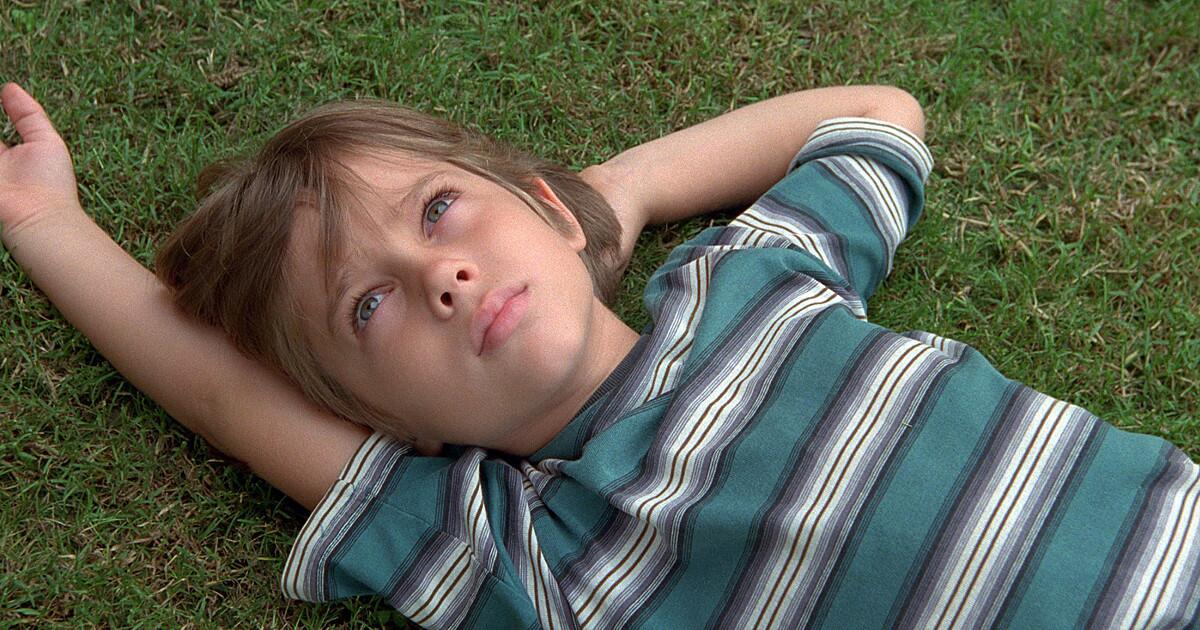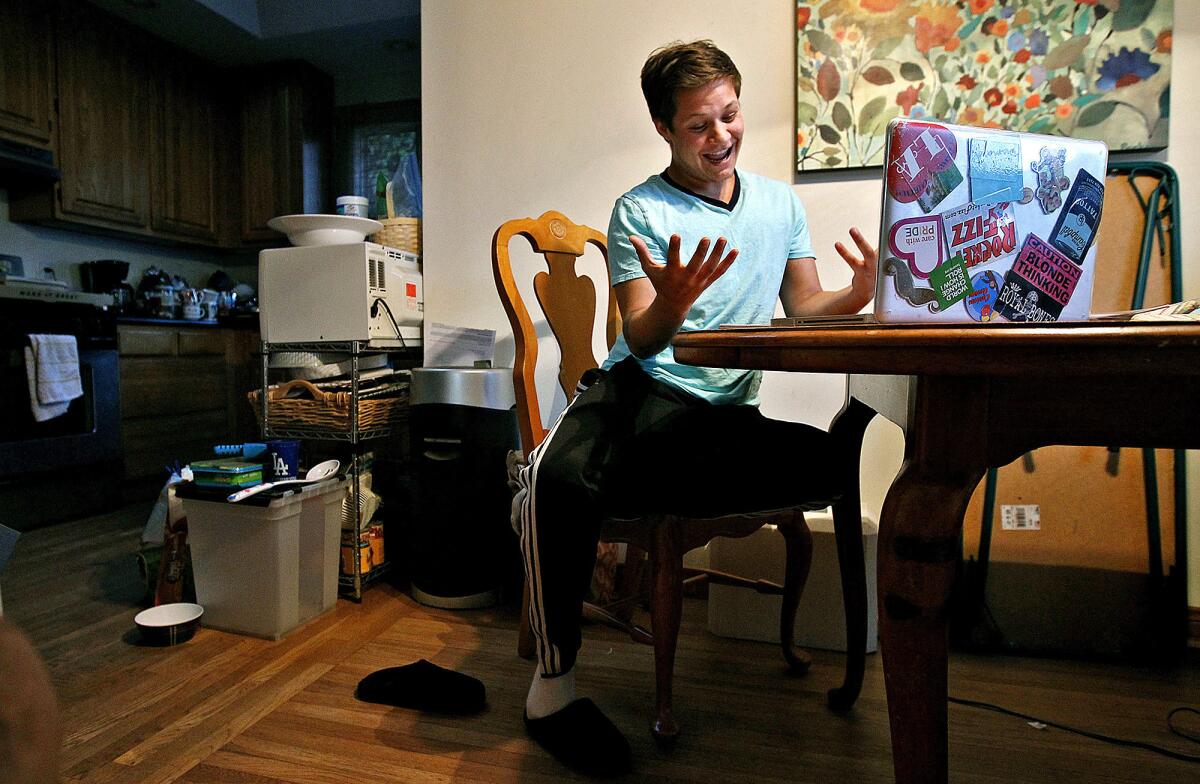A mosaic-loving family’s journey of many tiles
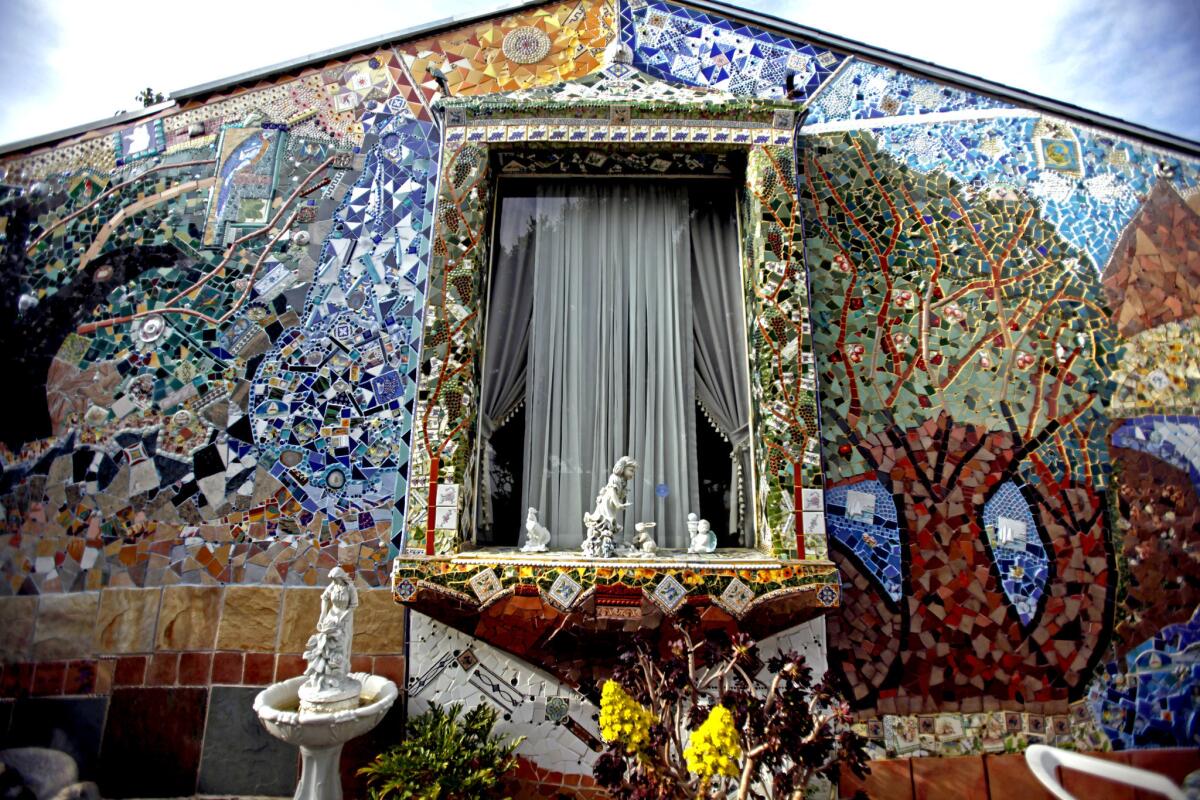
It began 13 years ago with a periwinkle square. Now Aziz and Louise Farnam’s Santa Monica house is a shimmering montage of tiles.

The transformation started simply enough, with a molded ceramic tile of a flower framed by Celtic tracery.
Neither Aziz nor Louise Farnam can recall now where they found the periwinkle square, but, at their son Amiel's urging, they glued it to the upper-left corner of a low concrete retaining wall in front of their 1930s bungalow in Santa Monica.
Both had seen the elaborately tiled mosques and mausoleums in Esfahan, in their native Iran. It didn't take long before they were scrounging in Southland secondhand stores, Catalina boutiques and Las Vegas casino shops for more tiles, plates and figurines.
They collected pieces of cobalt blue, aqua, plum and yellows from pale to sunny. They broke or cut them with special nippers into irregular shapes and applied those to the wall, letting them radiate in no particular pattern from the original piece.
They finished that wall, then tiled the walkway to the front door.
From there, things escalated — to a traffic-stopping degree. Motorists routinely slam on their brakes to marvel at the eccentric artistry.
"Everyone knows my house," Louise said. "Just say 'mosaic tile house in Santa Monica.'"
About 13 years have passed since the couple set that first tile, and now the entire house on California Avenue at 26th Street is a shimmering montage that beckons the curious.
One morning about two weeks ago, Aziz, 65, fitted bits of plates, floor tiles and orange hearts on the last remnant of bare wall near the two-car garage. A school of whimsical ceramic fish — each planted in the center of a tile adorned with circles of blue, green, tan, white and red glass beads — swam through the section.
Aziz pointed above the fish, to a colorful bird plate. Atop it he had stationed a turkey. Both objects were treasures from Santa Catalina Island, saved for this crowning moment and placed high for their protection.
"Most of my family and friends, especially my father-in-law, say, 'You're crazy, you're stupid,'" Aziz said. "But people stop and say, 'I love it.'"
There has been no grand scheme, and Aziz's style and tastes have evolved. "Every hour you change the mind," he said. "There's always a new idea."
He was impatient to be done. Later, a hired helper would fill in the mortar.
How many pieces did he use to cover the house? "Twenty million," he says. Who's going to argue?

Steve Mount, who lives next door, has watched the venture from the beginning and even advised Aziz on the grape motif for the Farnams' picture window, next to the mosaic apple tree worthy of Genesis. "I'll be out gardening and people will screech to a halt," Mount said. "It's a wonderful conversation-starter."
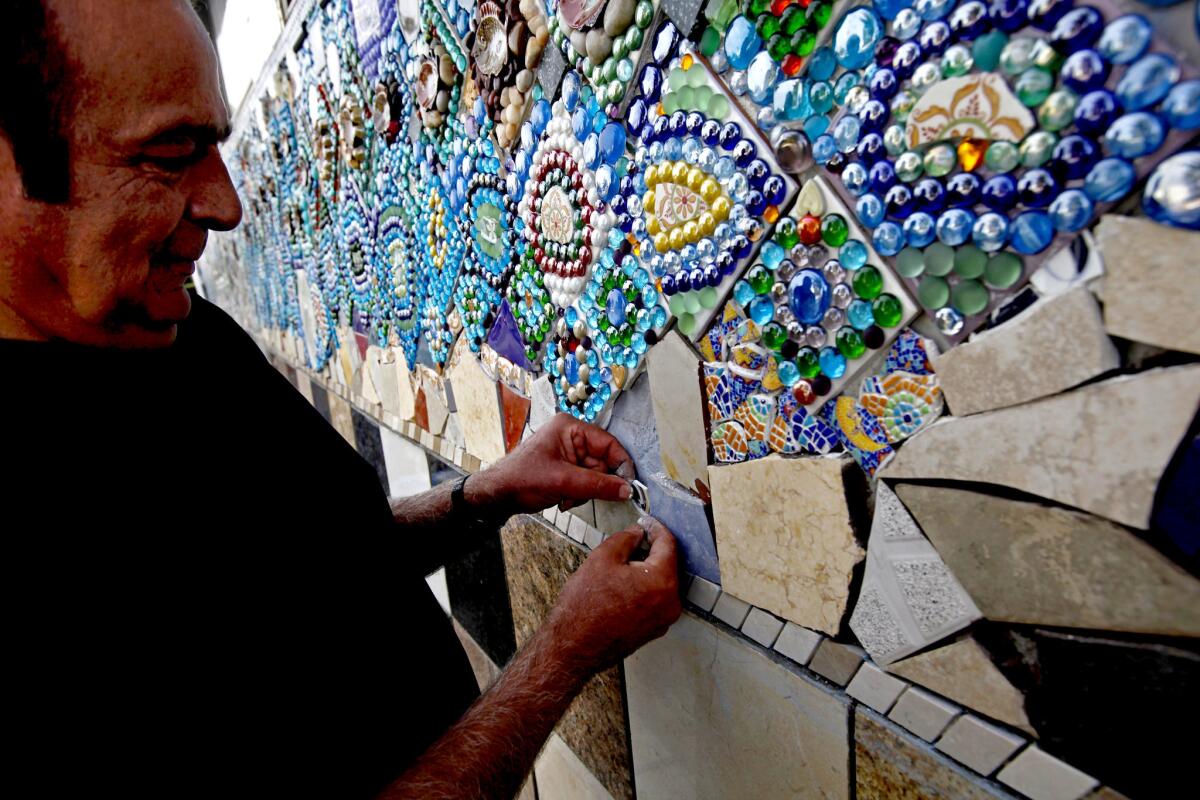
Azis Farman works on the last stretch of wall, the culmination of years of work. More photos
Out back by the alley behind their houses, Aziz installed a psychedelic version of the Hollywood sign, with small plates for the O's, to give Mount something fun to look at. It's just around a corner from a stylized synagogue with symmetrical doors.
Mount describes the home's exterior as a "'Where's Waldo?' event."
Look closely, there in the upper-left corner of the front wall. That's a tiled depiction of Princess, Amiel's green-winged macaw.
Walk along the side wall and behold plates with peacocks, lighthouses, palm trees and a kitten drowsing in a basket of yarn. A Delft-style tile with windmills stands out, as do mosaics of Shamu the orca, a unicorn, mountains, rivers and menorahs to honor the family's Jewish faith. There are tiles signifying the ocean: a seashell, a puffy fish, the scutes of a turtle's shell.
A coiled rattlesnake pops out. Aziz points out a $37 duck (a rare extravagance) and, for the children, a "Hey! diddle, diddle" Mother Goose tile, with the cat and the fiddle and the dish running away with the spoon.
Amiel, now 28, acknowledged that the visual stimulation can sometimes overwhelm. But he said he has enjoyed seeing his parents "work together and design something that everyone seems to love and adore."
I love that in Los Angeles everyone can express themselves.”— Neighbor Karen Kushi
The Farnams estimate that a fifth of what's on their house was supplied by friends, family and neighbors.
"I love that in Los Angeles everyone can express themselves," said Karen Kushi, whose home across California Avenue adheres to a much more Zen-like aesthetic.
Angela Contreras, an accountant who lives in Inglewood, recently parked illegally to take smartphone photos of the plaster angel on the front door and the sea creatures floating throughout. "It stopped me in my tracks," she said. "This is the coolest house in L.A."

The Farnams' madcap affair with mosaics began as an inside job. When another son, Ryan, was in fourth grade at Franklin Elementary School, Louise volunteered to help make mosaic items to sell at the school's Halloween carnival and fundraiser.
She learned the basics of making pictures or designs by arranging small bits of colored stone, tile or glass. Then, on her own, she bought plates at a secondhand store and covered a table lamp with pieces featuring miniature roses.
She expanded to floor lamps, coffee and dining tables, vases, plates, bowls, mirror frames and chairs, many of which fill the living and dining room of the four-bedroom house where she and her husband have reared six children. The bedazzling centerpiece is the fireplace, covered floor to ceiling with pieces of mirror in all shapes and sizes.
Aziz at first was not happy with his wife's newfound passion. "He called it psychobabble, breaking dishes," Amiel said.
At some point, Amiel talked his parents into turning the low retaining wall in front of their garden into a mosaic. Once that project was completed, he suggested they remove some faded Mexican tiles from the front of the house. With the tiles gone, the exterior urgently needed patching and painting. "Why bother?" Amiel recalled telling his parents. "Just cover it with mosaic."
They initially rejected the idea. So Amiel began to gather pieces to do the work himself. "The day I was supposedly going to get up to do it," he said, "they came with their own feedback." His parents took it from there, letting loose their quirky sensibilities.
In 2005, Louise started a business to make custom mosaic items. By that time, she had turned over the exterior to Aziz, who had put aside all of his reservations.
On weekends, Amiel recalled, Aziz would eat breakfast and then create mosaics until the sun went down, stopping only for lunch. The work became therapeutic as the recession tamped down his import business.
The Farnams say they would love a bigger house because four of the children still live at home. But they agree that it would be tough to leave their one-of-a-kind creation behind. Louise considers it a showcase for her art — a new take on the ancient tilework of her homeland.
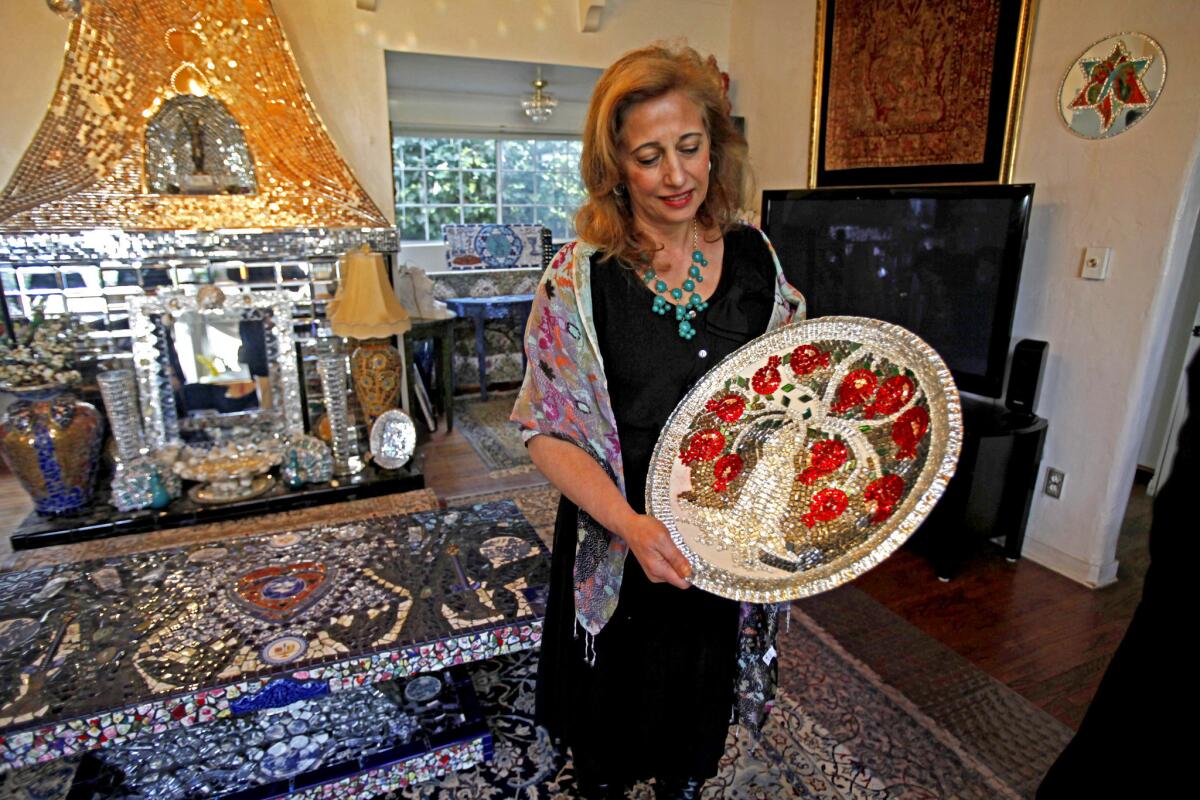
Louise Farnam holds a platter she made. She also decorates mirrors, tables and other interior furnishings, which she sells via her small business. More photos
Before she fled Iran in 1981, two years after the Islamic Revolution, Louise had been a midwife. She escaped by horseback and bus to Turkey. She made her way to Israel and, finally, Northern California. Aziz had escaped Iran earlier, leaving substantial family assets behind. A friend introduced them. They married and moved to Santa Monica.
Louise, 58, has become a U.S. citizen. Aziz retains his Iranian citizenship, in the hope of one day reclaiming the family wealth.
Last year, the TLC television network featured the tile house in a segment of its "Four Houses" series. Two of Louise's rivals dissed her house as a "sensory-overload … hobby gone wild." Nonetheless, Louise took top honors, winning $10,000 and beating out a water tower residence, a Modernist cube and a big Calabasas house.
Along a narrow walkway at the side of the house, Aziz lifts a curtain to show shelves stacked with plates and cups and yogurt containers filled with beads and broken pottery.
Might they tile some more? "I don't think so," Louise says quickly. "There's no more wall."
Aziz's offhanded response: "Only the roof."
Follow Martha Groves(@marthagroves) on Twitter
Follow @latgreatreads on Twitter
More great reads
At Mammoth, he molds the snow to launch Olympic hopefuls

It's a lot like sculpture. Either you have the eye or you don't.”
Sign up for Essential California
The most important California stories and recommendations in your inbox every morning.
You may occasionally receive promotional content from the Los Angeles Times.
